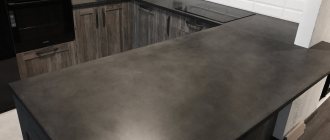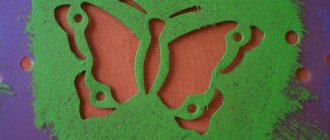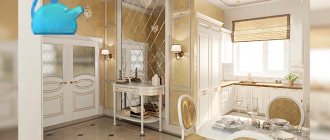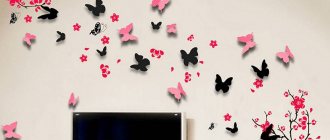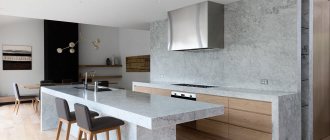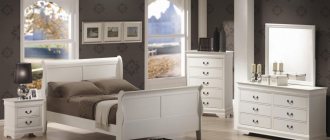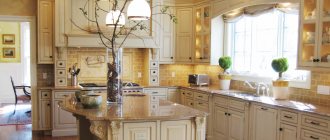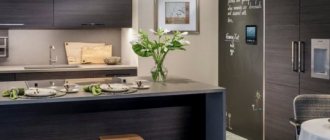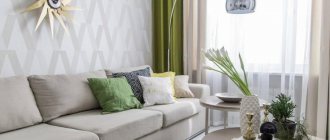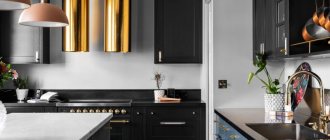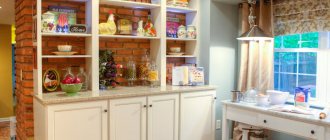Features of modern frescoes
Fresco is a wall style of painting. To create a unique pattern, the surface is specially prepared, and the pattern is created by hand by the artist. Carrying out such masterpieces requires not only painting skills and inspiration, but also great patience. This is labor-intensive work that requires a lot of time and effort.
Modern manufacturers of finishing materials have not ignored the growing interest of consumers in this decor. Nowadays, in order to create a fresco on the wall in the kitchen or living room, it is not necessary to invite a professional artist. The market's assortment includes self-adhesive materials that everyone can handle.
Anyone can handle self-adhesive frescoes
Those who want to include a fresco in the interior of the kitchen, to ensure its uniqueness, have the opportunity to choose an application technology, on which the aesthetic indicators and image properties depend. The basis can be
- plaster,
- canvas,
- hard surface,
- non-woven wallpaper.
The fresco will provide uniqueness to the kitchen interior
When choosing a type, you need to take into account financial capabilities. Frescoes made on different types of materials differ significantly in price.
Types of modern frescoes ↑
Just a few decades ago, when figuring out what frescoes are, one could come to a definite answer - a drawing on wet plaster. But nowadays they are presented in a wide variety of species, since new technologies make it possible to use these decorative elements in a variety of formats - we’ll get to know them further.
Frescoes are a stylish and non-standard solution for transforming the kitchen interior
On wet plaster ↑
A traditional decorative option is painting on wet elastic plaster: first, relief plaster is applied to the wall, then it is tinted in the required color, after which an artistic image is made on the resulting background. The strength of the finish is achieved through the use of a special mounting mesh. Only natural paints are used to create the drawing.
Painting on elastic wet plaster - a traditional type of fresco on the wall
This type of wall painting has many advantages: a unique design, ease of adjustment during the creation process, the possibility of restoration during subsequent use, masking of unevenness of the base due to a layer of plaster. However, it also has disadvantages: high cost and complexity of implementation - the work requires professional skills, the use of special tools and compliance with temperature and humidity conditions in the kitchen.
Note! Despite their external sophistication and fragility, frescoes on plaster are distinguished by high performance properties - they are not abrasion-resistant and are not afraid of moisture, so they can withstand wet cleaning.
On canvas ↑
Painting on canvas is another painstakingly executed, but exquisite option for a wall mural. It is made entirely by hand: a base of lime powder and river sand is applied to a cotton canvas, and then a drawing is made on the dried base using natural paints. In some cases, to create the effect of realism, the painting is artificially aged, adding abrasions to it.
In stores, such frescoes are sold in the form of ready-made canvases, rolled into a roll - all they have to do is fix them on the wall using wallpaper glue and treat them with a protective wax composition. But when purchasing such a finish, you should also take into account its significant drawback - the difficulty of care: the painting can only be washed with a slightly damp soft cloth without any effort, since there is a high risk of damage to the coating.
Decor on canvas will be the highlight of any kitchen
On non-woven fabric ↑
Non-woven fresco wallpaper is an alternative to manual labor for creating a decorative image: the drawing on the canvas is done using a printer. Thanks to special paint application technology, this finish does not fade or fade, so it retains its original appearance for a long period of time. An absolute plus of the canvases is ease of installation: they are glued in the traditional way using glue for non-woven wallpaper.
Note! To give the non-woven finish a more “live” appearance, you can paint additional elements of the composition on the canvas.
Non-woven fabrics are easy to glue, but no less effective than natural painting
Self-adhesive photo wallpaper ↑
Self-adhesive photo wallpaper for frescoes on the wall is the most financially accessible type of decorative finishing. It is performed using a printer: an artistic image is digitally applied to a smooth or slightly embossed canvas. Photo wallpaper is suitable for covering plastered and painted walls. But it is important that the base is even, since the self-adhesive sheet is quite thin, so it will not hide defects in the rough surface.
Important! Self-adhesive is not recommended for use in the kitchen work area - here it will quickly wear off, fade and lose its presentable appearance.
Self-adhesive on the wall - an affordable way to give the interior a new character
The undeniable advantages of traditional fresco
The classic method of wall painting is in high demand among lovers of refined, prestigious interiors. The charm of such a fresco is undeniable. The surface of the wall is plastered with relief material. Then it is painted in the desired tone for the background. An image is created on it. The painting uses durable paints from natural ingredients. Photos of frescoes in the kitchen made using this technology allow you to see the incredible attractiveness of this decor.
Fresco in the kitchen in a modern interior
Despite the fact that this method is considered classic, it is slightly different from what was used in ancient times, in the Middle Ages. Nowadays, innovative technology developed by Italian masters is used to create frescoes. To strengthen the plaster layer, a reinforcing metal mesh is used. The compositions of the mixtures include fillers that provide the material with increased elasticity. Frescoes created using this method:
- perfectly imitate ancient works of artists;
- are resistant to moisture;
- do not fade in direct sunlight;
- retain their original appearance for many years.
Frescoes can retain their original appearance for many years
A significant advantage of this technology is the affordable cost of work. There are no restrictions on the subject of drawings. It is possible to choose an option based on the features of the interior and its style. The decor is environmentally friendly; only natural materials are used in its creation.
Unique fresco on canvas
The technology of frescoes on canvas has long been used in luxury interiors. Craftsmen prepare and level the surface of the wall, the artist manually creates an image, artificially ages it, giving the appearance of a fresco made several centuries ago. This decor perfectly decorates the room and gives it a majestic, antique look. But the cost of custom-made work is high, affordable for a narrow circle of consumers.
It is possible to purchase a ready-made finishing option. The photo catalog of kitchen frescoes presents works created in Italy and Spain. Modern production includes several stages. A solution of lime powder and fine sand is distributed on the canvas. After the base has dried, the artist creates an image using natural paints. Then abrasions are created, giving the appearance of an antique fresco.
The fresco perfectly decorates the kitchen in any style
Finishing using ready-made canvas will not cause any particular difficulties:
- A reliable adhesive designed for heavy wallpaper is applied to the wall surface;
- the canvas with the fresco is fixed;
- the image is treated with a protective composition based on wax.
This decor cannot be washed, but it is highly resistant to external influences and retains its original beauty for a long time.
Advantages and disadvantages of frescoes in the kitchen
Since ancient times, exquisite wall paintings have adorned luxurious estates and palaces, emphasizing the high status of their owners. Over time, the art of fresco changed and became accessible to ordinary people. Modern technologies have simplified the process of producing such decor. The use of painting in the kitchen seems unusual only at first glance.
A fresco on the kitchen wall has a number of undeniable advantages:
- resistance to fading, moisture and dirt - high-quality paints and varnishes reliably protect the surface of the canvas;
- long service life - competent execution of application work at the initial stage - guarantee of maintaining the appearance of the pattern for a long time;
- originality - modern technologies allow you to create an image of any complexity, including transferring a photo to the wall.
The disadvantages of frescoes in the kitchen interior include:
- careful care and use - decor on a non-woven basis requires delicate use due to the thin base;
- high cost - painting done using classical technology is a labor-intensive and expensive process.
Fresco on non-woven wallpaper
Many consumers have already appreciated the benefits of non-woven wallpaper. One of the advantages of these materials is the excellent leveling of the wall and the elimination of any minor defects. They are an excellent basis for frescoes. A thin layer of plaster is applied to the surface, on which the image is created.
Using this technology, murals on the kitchen wall can traditionally be created by hand by artists. But there is a more economical way. Nowadays, specialists have professional printers in their arsenal that can transfer any desired image onto the base. This way:
- provides an unlimited selection of drawings and paintings;
- guarantees high transfer accuracy and color saturation;
- saves costs on creating decor.
Any image can be transferred to a non-woven base.
Frescoes created on a non-woven base can be artificially aged. For this purpose, special impregnation is used. Its application to the image creates a network of tiny cracks. The fresco perfectly imitates the work of ancient masters.
On what basis are frescoes made in the kitchen?
The classic option is to make a design on wet plaster. The production technology is very simple - textured plaster is applied to the surface, then it is tinted in the desired color, after which patterns are made. This method has many advantages:
- there is no need to perfectly align the wall;
- the drawing can be changed or adjusted;
- the image can be restored;
- easy to clean and not afraid of moisture.
The main advantage is that the fresco will be made according to an exclusive design.
Among the disadvantages:
- high price;
- compliance with a certain temperature and humidity;
- availability of necessary working tools.
Nonwoven
Products on a non-woven basis are characterized by an affordable price and ease of application. The canvas is covered with a small layer of plaster, literally a couple of millimeters, and the pattern is created using color photo printing. To make it look like ancient frescoes, the image can be artificially aged. In order for the product to be used in the kitchen, it is coated with special impregnations.
They are attached to the wall using non-woven wallpaper glue.
Hard base
Another name for this type of fresco is solid wallpaper. They are usually small in size and heavy in weight.
They are made by hand: a solution is applied to a base (wooden or ceramic), and then the selected image is transferred. To make it look like antique works, the edges of the base are pinched. A custom-made product looks expensive and has a corresponding price. Cost of 1 sq. m can reach 12 thousand rubles.
The fresco can be hung on the wall like an ordinary picture or glued to a solution that has not yet dried.
Flexible plaster
The most popular option is work done with an elastic solution. The base acquires this property thanks to modern technology, which was developed in Italy.
For strength, a mounting mesh is attached to the plaster, which also serves to protect against the appearance of cracks when bent. The design is applied using natural paints using the digital printing method. To give the product a finished look, the fresco is finalized by the artist - he creates texture and relief.
It is attached to the wall using mounting adhesive, and the remaining free space is finished with ordinary decorative plaster. This technique creates the impression that the canvas is completely handmade.
The advantage of this product is that it is not afraid of water and does not fade in the sun.
The cost ranges from 3 to 7 thousand rubles per sq. m. m.
Canvas
This type of fresco is made using natural fabrics, usually cotton or linen. Lime, sand, glue and special natural pigments are also used. They give the product strength, that is, they create a protective and decorative coating that protects against exposure to ultraviolet radiation and moisture.
This type of canvas is done by hand. As a rule, the production of frescoes on canvas is carried out in European countries, so their price is high - from 25 thousand rubles per sq. m. m.
Self-adhesive
Works on a non-woven basis are created using paste, which is made from tiny grains of sand. It is applied to self-adhesive material, and the design is applied using color printing. Installation of the product does not cause any special problems; you just need to remove the special protective layer and glue the fresco to the wall. Due to the fact that the plaster layer is very thin, the surface must be carefully leveled.
The canvas is very different from the real products and resembles embossed wallpaper. They are made in Italy or Spain, so they have a fairly high cost.
Heavy murals and self-adhesive materials
There is a special type of frescoes that have high artistic value. These images are thick and heavy, and have special chips on their edges. It is difficult for a non-professional to distinguish such works from frescoes preserved from ancient times. These expensive decorations require a rigid base that can withstand heavy loads.
The most affordable option for those who want to use frescoes in the interior of the kitchen without high costs are semi-finished products on a self-adhesive basis. Such materials are also produced by Italian and Spanish brands. The disadvantages of this decor include:
Ready-made frescoes will decorate the kitchen interior without high costs
- the need to carefully prepare the base, since all the smallest flaws will be noticeable;
- there is no antiquity effect in these images;
- the drawing is created digitally and is not unique.
However, in this category you can find the perfect interior decoration. Photo catalogs of kitchen frescoes contain many interesting, beautiful images in various themes.
Frescoes in the interior - how to use them? 77 photos of new designs.
Modern materials are amazing; you can decorate any room with artistic paintings and antique elements of temples.
Frescoes in the interior are quickly becoming popular, creating an aura of majestic medieval beauty.
Classification of frescoes
Wall materials have become so varied that murals in home interiors have become affordable. Let's look at the types of wall paintings in detail:
Classic frescoes
The technique of applying a pattern to wet plaster, as in ancient times. Michelangelo and Leonado da Vinci painted huge areas in the traditional manner within 1 day.
The complex process did not allow for corrections. The high cost and labor intensity makes this painting almost impossible.
Fresco on canvas
The drawing is applied to a canvas previously coated with a specialized composition. Natural pigments replace paints. For realism, the image is artificially “aged”.
When coated with wax, this type of fresco will last for many years.
Frescoes on a self-adhesive basis
They are similar to textured wallpaper (photo wallpaper). A small layer of special plaster is applied to a self-adhesive base, then glued to the wall.
The wall must first be perfectly leveled; there is no way to “age” the surface.
Frescoes on non-woven fabric
This decor is more often used in large areas; it differs little from frescoes on canvas. This is a more complex method, the drawing (photo) is made on a printer with a base for non-woven wallpaper.
Frescoes on a rigid base
Wood, plastic or ceramics are used for the base, simulating chips and small cracks.
The disadvantage is the large weight of the fresco. The small size of the fresco will fit perfectly into a small room, and “get lost” in a spacious one.
Fresco on elastic plaster
This type of fresco is close to the classics. The difference is that the plaster dries slowly, which means the master has more time to work. The drawing is manually applied to the wall, so the price is high.
There are many design options for wall paintings. The choice depends on the wishes of the customer and his capabilities.
You can create frescoes in the interior of a hall, bedroom, children's room, kitchen, even hallway. The main thing is that the image corresponds to the functionality of the room and its design.
How to correctly fit frescoes?
Nanotechnology in finishing materials has made frescoes a possible design element.
The interior of a kitchen or other room also depends on the characteristics of the room. You should take into account the size of the wall, color scheme, and theme.
The intended furnishings in the room should also be taken into account. For example, if the bedroom interior is simple, then a drawing from the “Abstraction” series or from high-tech will not be suitable.
The frescoes in the living room are large-scale paintings covering the entire wall; this is a large space for decoration. More often, panoramas of cities, landscapes, and flowers are used in the hall. If there is wicker furniture in the living room, then sea coasts will do.
Murals for the kitchen should be selected taking into account high humidity, where high temperatures are possible. The plot according to the preferences of the home owners and style: still lifes, floral prints, landscapes, etc.
Frescoes in the bedroom should convey peace and tenderness. Romantic landscapes, sea themes, photos of the sky, panoramas of resorts are suitable.
The color of the painting should be soft shades. These are peach, pink, creamy, as well as blue, salad, lilac, sand shades.
Frescoes in the children's room in accordance with the age of the child. Stories from fairy tales, cartoons, images of princesses, elves, and gnomes are ideal for little children.
They like animals, butterflies, birds, cars. This could be a hobby (sports, dancing, music).
Beautiful drawings with a 3D effect will expand any room.
Photos of frescoes in the interior
Advantages of decor, its specifics
The growing popularity of this type of decor is due to its obvious advantages. Fresco:
- is a unique decoration, gives the interior individuality;
- has high strength, will retain its beauty in difficult kitchen conditions;
- can be created on any type of surface;
- environmentally friendly;
- can be used in any interior style;
- retains its original appearance for a long time.
Frescoes can be created on any type of surface
Numerous photos of frescoes in the kitchen posted on Internet sites make it possible to verify the attractiveness of such interior elements. You can choose an option for both a spacious and a small room. The sizes of images created manually are selected taking into account the available space.
Benefits of painting
Decorating with a fresco adds a sophisticated touch and adds individuality.
Kitchen painting can be presented both in a classic form and contain modern motifs. The image is applied to the surface of the wall or ceiling. The integrity of the design is given by decorative elements that emphasize the character of the painting. The paint coating, due to its practicality, will last for a long time. It will provide protection against fading, and its moisture-proof properties will allow you to clean without difficulty removing dirt. With the help of a fresco you can find yourself at a coastal house or find yourself in the world of the Middle Ages. The final choice is yours!
The most commonly used motives are:
- World map;
- historical event;
- still life;
- covering with ornament;
- popular reproductions;
- photographs from personal archive;
- city;
- classic canvases;
- ethnic note;
- beauty of the landscape.
A full-wall painting is a bold decision, but the right combination in style will create a harmonious image. A small mural in the kitchen can take place above the stove or table. This coating will look advantageous in comparison with wallpaper or decorative plaster.
Frescoes in designer styles
Particularly popular are artificially aged frescoes that imitate ancient painting. Therefore, there was an opinion that this decor is only appropriate in classic designs. Indeed, on websites you can see many photos of interiors with a fresco in the kitchen in classic and antique styles. But you shouldn’t limit the scope of application of this decor so much. Thanks to innovative technologies for creating wall decorations, this finish can be used in any design, even ultra-modern ones.
Unlimited possibilities in choosing the subject of images allow you to find an interesting solution, taking into account the nature of the situation, the atmosphere that needs to be created in the kitchen. The interior may appear:
- ancient ruins, famous landmarks;
- medieval castles and palaces;
- romantic motifs of the Renaissance;
- wonderful natural landscapes;
- urban panoramas;
- celebrity portraits; world map, etc.
The theme of the fresco is selected taking into account the nature of the situation
When choosing an image for a fresco on the wall in the kitchen, you need to focus on the main shades and other types of finishes. In this case, the design will be harmonious, and the unique decor will appear in all its glory and become a worthy decoration of the interior.
Features of the frescoes
When choosing frescoes for the kitchen wall, you need to take into account two important points - the existing interior of the room and the type of covering with which you are going to decorate the room. You will learn more about all this in the presented section.
The choice of pattern largely depends on the existing kitchen interior
Wall painting and interior styles
One of the reasons why kitchen murals are so popular is that they can fit into almost any decor. Eg:
- Classic . Frescoes in the interior of a kitchen in a classic style are distinguished by their exquisite simplicity of lines and slight pretentiousness. The plots of kitchens in a classic style can be very diverse. Renaissance motifs, antique paintings or mythological scenes, floral patterns and still lifes are suitable.
Classical decor is characterized by landscapes, still lifes and Renaissance motifs
- Minimalism, loft and hi-tech . These styles are characterized by rigor but effective lines, slight negligence, and the use of rich shades. Accordingly, the frescoes for the kitchen should be bright, with a distinctly rough texture of the base. You can choose models that imitate three-dimensionality, complex mosaics and geometric lines.
Geometric abstraction is an excellent solution for minimalism, loft or hi-tech style
- Provence and country . The kitchen interior with a fresco in the Provencal style will help you mentally transport yourself to the coast of the Cote d'Azur or a house in lavender fields. Select an image of rural houses with pastel colors. For country style, canvases with imitation of stonework, rough plaster with cold tones will be appropriate.
Landscapes in pastel colors will complement the Provence style kitchen
- Eastern . Frescoes on the kitchen wall should contain elements of oriental painting. Images of sakura branches, flowers and bamboo are welcome.
The image of sakura will add lightness to the space
Types of frescoes - an overview of 4 application technologies
The most popular are several ways to obtain artistic painting. After studying their pros and cons, you can choose the appropriate option for creating a mural on the kitchen wall.
In addition to painting on living plaster, there are options on non-woven backing, canvas or self-adhesive film
Painting on wet plaster
Traditional technique borrowed from history. You can’t do this without the advice and skill of professionals. The image is applied directly to the wall surface, following technology and using natural paints. Such frescoes are equated to original works, and their price is very high.
To create a painting on wet plaster, special tools and skills are required.
This is a very painstaking and labor-intensive task that requires a lot of time and effort. In addition, the creation of a fresco using this technique is accompanied by the presence of “wet” processes and must be carried out under temperature conditions.
The color of the image must be matched to the wallpaper
Painting on canvas
Its creation is based on the use of natural materials - lime, natural pigments, sand (special composition), glue of natural origin and, in fact, the canvas itself. The instructions for creating them look something like this: the fabric is the base for the plaster layer. At the next stage, a drawing is applied, after which “traces of centuries-old dust” are artificially created on the finished work - abrasions, cracks, fading.
Painting on canvas is framed with a decorative frame
For sale, images on canvas come on stretchers or separately packaged rolls. A correctly selected canvas can become the highlight of any design. However, difficult maintenance and some impracticality limit the scope of use of such frescoes.
In terms of care, drawings on canvas are the least practical
Drawing on a self-adhesive basis
A very popular type of painting. A similar fresco in the kitchen can be easily applied at home with your own hands, without requiring special tools or skills. All you need is a paint brush, the material itself, tape and glue. The principle is very similar to the “decals” that we pasted on refrigerators as children.
Using a pattern on a self-adhesive basis, you can decorate a spacious room
Non-woven images
The Italians achieved perfection in this technology, replacing the manual labor of applying texture and paints with specially equipped lines and special printers. Since the canvases are pasted like non-woven wallpaper, they are used to create dimensional images.
Frescoes on a non-woven basis are glued in the same way as simple wallpaper
A fresco in the kitchen interior, made using a similar technique, will perfectly decorate the wall and retain its bright colors and attractiveness for a long time.
A kitchen with a fresco will not lose its charm even after several years - the paint is not susceptible to fading in the sun
If you wish, you can do the artistic painting yourself. This method can be used to decorate borders or door and window openings.
Wall painting in classical styles
Classic styles are often chosen to decorate kitchens. They give the room a sophisticated, elegant look. The popularity of these trends practically does not depend on changes in fashion; you can not change the situation for many years, it will meet the standards.
Photos of frescoes in the interiors of kitchens in a classical style are widely presented on the Internet. There are many options for such designs. They differ in character and theme:
- imitation of antique painting will provide grandeur and pomp;
- natural landscapes add comfort;
- Renaissance style images create a romantic atmosphere;
- city panoramas add a touch of sophistication.
Natural landscapes create a comfortable atmosphere
This decor is great for Provence and country. These designs are cozy and warm. They look harmonious with village and garden landscapes, fields with sunflowers and lavender. In Provence you can create views of the sea coast. These interiors often use various still lifes and imitations of brickwork.
The city panorama will add a touch of sophistication
The fresco will be an ideal decoration for any ethnic style. Eastern destinations are especially popular now. Blooming cherry blossoms, bamboo, and a pagoda will look great in a Japanese or Chinese interior. You can choose a fashionable African style for the kitchen, decorate it with pictures of the jungle or savannah. Frescoes on the wall in the kitchen will help support the chosen direction and make it more expressive.
Modern decoration with frescoes
Modern technologies make it possible to create any image by hand painting or by printing. This decor can be used in high-tech and minimalism, loft and art deco, industrial and fusion. It is easy to choose paintings that correspond to these areas of subject matter. In the photo of murals for the kitchen in modern styles you can see:
- portraits in pop art style;
- cityscapes;
- three-dimensional graphics;
- compositions of geometric shapes;
- technical drawings;
- mechanisms, etc.
Fresco in the kitchen in a modern style
Such images become the highlight of the interior and provide it with uniqueness. Full compliance with the theme and design canons guarantees impeccable harmony.
Beautiful frescoes for the kitchen TM KLV
In our interior you can find wallpaper frescoes for the kitchen in the widest range. Here you can find almost any image that is worthy of decorating the walls of almost any room. If the kitchen cannot boast of being too large, we recommend that you opt for light shades that allow you to visually make the room larger. But it’s better to avoid dark and gloomy tones - this is not a very good option for a small room. It is also important to pay due attention to the plot that will be used in the interior.
The photo that will be used in the interior for the mural in the kitchen is responsible for creating the appropriate atmosphere. Therefore, you should avoid aggressive plots and pictures with negative energy - otherwise you simply won’t get a bite in your throat. It is better to give preference to neutral options or even choose a theme that matches the purpose of the room. Photo wallpaper murals for the kitchen, which we can present to your attention, are distinguished by a wide variety, so you can easily purchase the most suitable option. And the cost and quality of all proposed items will pleasantly surprise you!
Placing frescoes in the kitchen interior
The kitchen has a specific interior. Traditionally, one of the walls is occupied by a set with a work area. It is impossible to place a full image on it. This decor is a presentable decoration, it is necessary to show all its advantages. The best option is to place the fresco in the kitchen on a wall that is not occupied by other objects. You should not install furniture that blocks the image, this can spoil the impression and will not allow you to present the drawing in all its glory.
The fresco is created on a wall free from furniture
It is advisable to create a fresco in the interior for a large kitchen. This decor requires space. However, it is possible to decorate a small room with a unique image. If there is no free wall for painting, the fresco can become an apron located in the work area. There are types of decor that are not scary:
- moisture,
- steam,
- high temperatures,
- drops of fat.
Their surfaces are cleaned of any contaminants. A fresco apron will be an effective decoration for a small kitchen, making it original and attractive. The theme for the image is selected in accordance with the specifics of the interior. These can be dishes that stimulate appetite, berries and fruits, flower arrangements, etc.
An apron-fresco will become a spectacular decoration
A good option for a small kitchen are small fresco inserts. They can be placed on any wall. Photos of interiors with frescoes in the kitchen will help you choose the right theme to create the right atmosphere. You can apply beautiful landscapes and still lifes to furniture facades.
Frescoes on the wall in the interior of the kitchen: fantasy come true
Frescoes are one of the oldest areas of fine art. They were used back in Ancient Rome to decorate houses and emphasize high status. In the last decade, frescoes have soared to the top of popularity and have become one of the most sought-after interior decor items, not only in formal living rooms, but also in ordinary kitchens, which seems unusual only at first glance.
Frescoes: advantages and disadvantages
A bright fresco will become the highlight of the kitchen.
The spread of such decor is also helped by the fact that, thanks to the latest technologies, a variety of materials, and a reduction in production time, paintings for kitchen walls are produced on an industrial scale and are available to everyone.
The advantages of modern frescoes are the high quality of paints and materials, which prevent fading and protect images from moisture and dirt. In addition, frescoes can help in zoning the kitchen and living room, unobtrusively delineating both rooms.
Even under the influence of kitchen fumes, the paints will not fade for a long time, and they can be placed anywhere in the kitchen, even at the sink or on the fronts of cabinets.
In the interior of the kitchen
A drawing on the wall in the kitchen will help become the main detail of the interior, turning a utilitarian kitchen space into one of the most beautiful and cozy places. Due to the versatility of their sizes, it can be either a painting on the entire wall or elegant small panels on the wall, which are suitable for both large and very small kitchens. But the greatest advantage of this decor is the ability to use it for any interior style.
Read how to fit a plastic kitchen apron into the kitchen interior on
Classic style
In a classic interior, landscapes or ancient scenes are most often depicted.
The classic interior style is the most popular. This is not surprising, since it has absorbed the best achievements of fashion and architecture of many centuries. Its main features are clear geometric shapes, exquisite simplicity of lines, expensive materials and stucco. It is not surprising that the fresco fits perfectly into such an interior.
The designs for kitchens decorated in a classical style are striking in their diversity: Renaissance motifs, Italian and French paintings, antique paintings and mosaics.
Frescoes often depict landscapes, animals, mythological figures, still lifes and ornaments. The author's unique painting is also often used.
For kitchens in a classic style, it is advisable to contact artists who work with paintings on wet plaster.
High tech, loft, minimalism
In modern interiors, frescoes on a non-woven basis are sometimes used, which is like photo wallpaper
Such styles are classified as masculine interiors for their strict but effective lines of furniture, unusual wall decor, deliberate roughness, the use of dark rich tones and boldness in the choice of works of art.
Frescoes in such an interior should be bright and catchy, with frequent use of computer graphics. These are imitations of complex mosaics, three-dimensionality, emphasized by the deep texture of the material.
The style of the interior can be given by both avant-garde images and fashionable photographs embodied in volume, black and white drawings and complex steel mechanisms.
Country and Provence
Landscapes of the south of France are most often depicted in the Provence style.
Recently, Provence style decoration in kitchen and country interiors has also become increasingly popular. They are valued for the indescribable spirit of a real home, cozy and warm.
For country design, you can remember and bring into your kitchen a piece of cold and harsh countries, where preference is given to rough but reliable stonework, rough plaster, and a successful combination of dark and light cold tones.
Provence, on the contrary, will remind you of the tenderness and tranquility of small French rural houses, filled with light and delicate shades of decor. Frescoes would be appropriate when creating a design in the shabby chic style.
For such an interior, it is better to choose small frescoes of a romantic style depicting pastoral motifs or European architecture and landscapes.
Venetian style in wall painting, look at the photo and video:
Ethno style
But these Ukrainian motifs, also as an option for a fresco
Ethnic style in the kitchen interior will allow you to recreate a piece of an exotic country through the use of traditional decorative elements, materials and colors.
A lush bouquet in the style of Petrikov painting is perfect for a modern Russian-style kitchen
Ethnic style is not limited to copying the homes of distant countries, it also reflects cultural traditions in combination with unique nature, awakening a certain call of ancestors, a craving for roots, which is very attractive to modern people in megacities.
Kitchens in this style are always full of bright colors and interesting things, and frescoes will fit almost perfectly.
They can be very diverse:
- Japan or China - fine, exquisite painting, both floral and landscape. Sakura flowers or peonies, bamboo and cranes will be a pleasant addition to a bright, spacious kitchen, and contemplating the misty mountains over evening tea will help you get rid of the negativity of the day.
- Egypt is a style that is incredibly in demand for modern kitchens. Cozy warm sand tones, light touches of gold and canonical painting perfected over centuries, ideal, for example, for applying to a kitchen apron.
- Africa is the rich, bright colors of the Moroccan style, awakening the appetite and driving away the blues. Murals can be either depicting African savannas or embodying traditional art.
Cherry blossoms are a symbol of Japan, so this mural is perfect for a Japanese-style kitchen.
Egyptian style is characterized by bright colors. Suitable for youth cuisine
But this bright African mural will bring the freedom-loving spirit of the savannah into the room.
Options
The increased popularity of frescoes has not gone unnoticed by companies involved in finishing materials. The latest developments have made it possible to create new types of frescoes, among which it will be easy to choose the option you like, both in terms of cost and quality.
Painting on wet plaster
The master paints by hand using a wet base as a canvas. Such work requires high professionalism, speed of writing and special working conditions (certain humidity and temperature). Some versions of frescoes can be applied to glass. Find out more about glass painting techniques here.
The advantages include:
- high quality and uniqueness of work;
- the ability to choose a pattern to taste with correction during application;
- high performance;
- ease of recovery.
The disadvantage is the high cost of work.
On canvas
A special mixture consisting of lime, natural pigments, sand (special composition) and natural glue is applied to the base in the form of a canvas. The image chosen by the client is applied to the dried composition and artificial “aging” is performed - abrasions, cracks and dustiness are added. Such frescoes are sold rolled up. In addition, such frescoes can replace false panels for the kitchen.
Advantages:
- complete imitation of classical painting;
- the ability to select any image without any loss in quality;
- cheapness.
Disadvantages: difficult maintenance and some impracticality limit the scope of use of such frescoes.
Self-adhesive painting
This type of fresco can be compared to ordinary stickers, since the image is on a special adhesive base.
Advantages: fast delivery, low cost, ease of installation.
Frescoes are made by applying texture and paints with a special printer onto a non-woven base. This wallpaper design can easily fit into almost any interior.
Due to its similarity to wallpaper, this material is used to create large canvases, which is impossible or labor-intensive compared to traditional techniques or canvases.
Nuances you need to know about
And this is how you can decorate your work area with a fresco
The same principle of choice works with frescoes as with other works of art or decorative solutions. They should correspond to the theme of the room, visually increase the space without dominating the surroundings.
Even in a small kitchen there is room for a fresco
Self-adhesive murals for the kitchen can be applied to any surface, but you need to carefully prepare the surface. Any flaw will be clearly visible, since such frescoes are very thin.
The more carefully the fresco is painted, the more charming it looks.
Read our article for interesting design ideas for kitchen decor.
Care and restoration
Frescoes are, perhaps, the only piece of furniture that does not require restoration during the process of dilapidation, since dilapidation is a plus, giving it a special charm. All types of modern frescoes can be wet cleaned.
The fresco will only look more beautiful over the years.
A boring apron can be enlivened with an interesting fresco
But such small ornaments can fit into an elegant interior
DIY wall painting master class in our video:
Frescoes on the wall in the kitchen interior are not only interesting kitchen design ideas, but also an excellent option to diversify the boring interior of the room. Painting on the wall looks elegant, looks interesting and is durable in use. And small abrasions, scratches or faded spots add only charm to the frescoes.
Creating a fresco with your own hands
Homeowners who have artistic skills and excellent taste do not have to hire artists or purchase ready-made images. They can create murals on the kitchen wall with their own hands. Consumables for this decor can be found in specialized stores. Hand painting will require a lot of effort and time, but the result deserves such efforts. An image made according to your own creative idea will be unique; well-chosen themes and a palette of shades will allow the painting to fit harmoniously into a specific interior.
You can decorate the environment with original decor without having the talent of an artist. You need to look at photos of frescoes in the kitchen interior on the Internet, choose a simple image option, or make a sketch yourself. After this you can start working. To create a fresco you need:
- qualitatively level the surface;
- apply plaster, cover it with primer;
- create the desired background;
- on the reverse side, paint over the sketch with a stylus;
- attach a sheet to the wall to make a mark;
- if you need to draw lines;
- color the drawing;
- After the paints have dried, cover the painting with wax or varnish.
You can decorate an interior with a fresco without having the talent of an artist
Of course, in this way it is unlikely to be possible to create an image similar to those that flaunt on designer photos of frescoes in the kitchen. But if you apply diligence and patience, and do the work carefully, a worthy decoration will appear in the interior. High quality modern paints and the presence of a protective layer will ensure the preservation of the image for several years.
Frescoes for the kitchen - interior design tricks
There are many ways to add a touch of sophistication and elegance to your kitchen interior. In addition to traditional ceramics and plaster, designers suggest using fresco, which came to us from ancient times. Previously, this finishing material was used exclusively for the decoration of castles and temples, so its use in the kitchen gives the room a special status. Murals in the kitchen offer the most original and non-standard interior designs, leaving behind designer templates and cliches.
Frescoes in the kitchen are incredibly beautiful
Fresco - features and characteristics
Before we get into practical advice on how to implement a design, let’s understand the terminology. Kitchen murals are historical or contemporary images that cover the surface of a flat or relief structure. The finished finishing material is a picture located on the ceiling or wall of the room.
The use of frescoes has become popular due to the creation of a special atmosphere. The finishing method transports household members to a mesmerizing Provençal meadow or the Cote d'Azur of the ocean. If you complement the kitchen with decorative items characteristic of the image (slopes, window openings, antique furniture, candelabra), then a solid composition will be formed, captivating with its originality.
Frescoes fit harmoniously into any interior
Murals for the kitchen are the latest development, which allows the use of various types and textures of material. Thanks to this, the final image can be flat or three-dimensional. With the help of modern tricks, an already magnificent drawing can acquire the missing liveliness and naturalness.
Advantages of use in the interior
The finishing material is very practical. Thanks to the high-quality structure, the composition is protected from fading, as well as resistance to moisture and various contaminants. This is a significant advantage of using frescoes in the kitchen.
The whole composition in the kitchen fascinates with its originality
The finishing material is convenient because it can be applied at any stage of kitchen renovation. However, it is recommended to think through the composition and its meaning at the initial stages of design development. Thanks to the fresco, the kitchen can become part of a medieval castle or be located at the pier of the endless sea.
Another advantage of the finish is its long service life. A chic renovation does not need to be repeated quickly, and the compositions applied will delight household members for a long time. If you decide to use a fresco to create an interior, then it is first recommended to decide on the place of the material in the style of the room - a solo decorative element or a pleasant background.
Fresco is the highlight of any interior
Unique design - choice of pattern
A kitchen with a fresco is unique in that the choice of its image knows no bounds. However, in order for the finishing material to look advantageous within the room, the painting must take into account the characteristics of the room and its general style. Popular directions for creating a composition are the following:
- world maps;
- historical events;
- still lifes;
- complex ornaments and intricacies;
- identical copies of paintings by famous artists;
- personal photographs;
- city scenes;
- Art Nouveau images;
- ethnic motives;
- landscapes.
Fresco in classical style
Fresco and size of the kitchen - how not to go wrong with the decor?
The kitchen is a quiet place where you want to relax, enjoy a meal and socialize with your family. Therefore, the fresco painting should correspond as much as possible to the general mood of the room. An important factor when choosing a fresco is the size and functional purpose of the room.
If you have a kitchen-dining room at your disposal, then the requirements for the design may change. In this case, the dining area can be decorated in the general style of the room, and the recreation area, where the family spends free time or meets guests, is decorated with a large-scale painting. In this case, the theme of the drawing can be anything, the peaceful direction can be discarded, and the attention of the composition is focused on a more dynamic and interesting scene.
The dining area is decorated with a large-scale painting
If the kitchen space cannot boast of an impressive number of square meters, then certain requirements are imposed on the size of the pattern and its meaning. First of all, it is recommended to focus on miniature decor. In the case of small narrow kitchens, you should choose a background design with a fresco or place a small emphasis on the composition. Wall decor in the kitchen of a small room should adhere to the following rules:
- placing the drawing exclusively on the walls;
- the use of finishing materials is not universal, but zonal;
- choosing thematic kitchen items as a composition;
- use of light colors for decoration;
- rejection of relief compositions in favor of flat designs that will not reduce the size of the area.
Fresco - varieties and their features
The classification of the finishing composition is based on the materials used to create it. The division of finishing also focuses on the method of its manufacture - manual or industrial. As a rule, the fresco is made by hand, which makes it unique and sophisticated. Some types of material use machine methods, due to which the effect of antiquity and exclusivity is lost. Each type has its own advantages and can decorate certain areas of the kitchen. Types of fresco:
- on a rigid basis;
- on canvas;
- non-woven;
- on flexible plaster;
- self-adhesive.
On canvas
This type of fresco is considered elite. It is not manufactured on a production scale, but is ordered individually for each kitchen. The finishing is created by painstaking manual labor and can take months to create a complete composition. The birthplace of fresco on canvas is Italy. The following materials are used to create the composition:
- lime;
- adhesives;
- cotton canvas;
- sand;
- dyes.
The production technique is very complex: the selected image is subjected to artificial aging and only then, using the specified materials, is transferred to canvas. The resulting composition is glued to the area of interest in the kitchen using ordinary glue, like wallpaper.
The image is covered with protective layers, but it remains sensitive to various types of damage. Therefore, it is recommended to place this decor away from the active kitchen area. The fresco literally “screams” about its exclusivity, so the overall decor should match it.
Self-adhesive
A budget-friendly type of finishing material, which is distinguished by a simple method of pasting and an equally simple appearance. The quality of the image cannot be compared to models on canvas. The material can be used on any surface – paint, plaster, wallpaper. The fresco has a fairly small thickness, so masking the unevenness of the wall is excluded.
Budget solution - fresco made from self-adhesive film
The main material of the composition is crushed sand. It covers the prepared synthetic base, and digital equipment transfers the design to the “canvas”. The variety of images is not impressive. However, such models can be ordered individually, designing a landscape of any complexity.
By using such frescoes you decorate your kitchen in an original way, but you shouldn’t count on the handmade effect. It is also recommended to place the composition away from the cooking area.
Non-woven
A wall fresco for a kitchen of this type is created by applying special plaster to a non-woven fabric. Here additional effects and original areas of the picture can be created. Next, the master draws the details of the composition, giving it a non-standard shade.
Fresco on non-woven fabric
The finishing material is easy to install, very resistant to kitchen “hazards” and can decorate almost any area of the room. The frescoes are characterized by realistic images and durability in use. This type is the most successful in the price-quality category.
On a rigid basis
Handmade, which is created on a special basis. The image can be used as a painting or mounted on a wall. This type of material can be applied directly to prepared blocks on the wall and created live.
Handmade murals are created live
The brightness and color of the work will amaze not only household members, but also their guests. The fresco is used as a bright accent in the design of the room. Size and contrast are determined by the customer.
On flexible plaster
By far the most popular type of fresco today. The main component of the material is plastic plaster, which is complemented by a thin mounting mesh. The design is created using dyes that are based on natural ingredients.
The model has an appearance as close as possible to ancient frescoes. Its surface is expressive and textured. Special foam is used for the installation process. After installation, the edges of the fresco must be treated with plaster. The model looks equally advantageous both as a solo decorative element and as a supporting element of the interior.
Fresco on flexible plaster is a practical and durable option
The finish is practical and impressively thick. If you plan to cover the entire wall with it, then you can forget about additional masking of unevenness. These models are not afraid of washing and cleaning. Any dirt can be easily removed with a damp cloth without harming the image itself. Fresco on flexible plaster is, without a doubt, the most practical and durable option for decorating a kitchen.
We decorate the kitchen personally
After choosing the type of fresco suitable for the dining area, it must be mounted on the wall or ceiling. You can do this yourself, but it is recommended to contact specialists. Difficulties with installation are kept to a minimum, however, delicate moments in the form of joining the panels should be entrusted to a professional. Otherwise, you risk ruining the plot.
You can fix the fresco on the surface yourself
Personal installation algorithm:
- preparation of walls - cleaning them, eliminating errors, priming;
- preliminary placement of the fresco in order to choose the correct placement angle and height;
- gluing the image using special glue (depending on the type of fresco);
- removing excess glue with a roller.
It is worth noting that when decorating a kitchen with frescoes, it is necessary to avoid the slightest drafts. Otherwise, the composition may not stick well.
Fresco window will expand the kitchen space
Results
Kitchen decor with frescoes is not only a popular trend, but also a truly unique way of decorating a room. In addition, the cost of frescoes (at least some of their types) differs slightly from traditional wallpaper, and the visual effect differs significantly. With the help of frescoes, you can hide uneven surfaces, create a unique composition and distinguish a room from the framework of “boring classics”.
Ready-made frescoes and stencils
If you have no artistic skills, but photos of interiors with a fresco in the kitchen aroused a strong desire to create the same decoration, you can use methods available to everyone.
Modern styles do not often use complex landscapes and panoramas. Minimalism, loft, hi-tech can be decorated with compositions of geometric shapes and various mechanisms. To create such drawings, you can use stencils, which do not require special skills to work with. If it’s difficult to come up with a design yourself, you can look at photos of murals in the kitchen in modern styles.
You can use stencils to create paintings on the walls.
Stencils are made of thick cardboard and coated paper. The leveled, plastered surface is covered with a background shade. When applying stencil designs, a foam sponge or brush is used. The dried image must be covered with a protective layer.
You can handle finished frescoes and wallpaper yourself. The wall needs:
- plaster
- prime,
- polish,
- cover with a thin layer of putty.
Every user can handle sticking a finished fresco
The gluing process uses a composition intended for non-woven wallpaper. If you choose a ready-made Spanish or Italian fresco for the kitchen in a photo catalog of famous brands, glue for fixing it on the wall is sold along with it. Every user can handle this job. It is important to act carefully and first apply markings for the exact location of materials. Excess glue protruding beyond the edges must be removed immediately. The adhesive composition is applied to the base.
Fresco and its types
The fresco is made individually or using machines. If you have the idea of using wall painting, then first of all determine what kind of fresco you need, its location and size.
Attention! The coating, made by hand, is unique, it gives a special charm. A machine-made drawing can be no less elegant, and its cost is much lower.
- Classic fresco in the kitchen. To create it, the surface of the wall is covered with plaster, tinted, and only then a drawing is created. After natural paints have dried, you can clean the surface with water. If necessary, the painting can be easily restored. The work is performed by a professional worker using special tools.
Advice. To preserve, maintain a certain humidity and temperature.
- Image on canvas. Sand mixed with limestone and glue covers the canvas. After this, the image is applied to the dried surface. Such work can be transported, it is easily mounted on the wall, and for preservation the image is covered with a wax mixture.
- A fresco made on glass has a number of advantages. Due to its evenness, it covers finishing defects, is securely attached and does not collapse under the negative influence of moisture.
- Non-woven fresco in the kitchen is the golden mean in terms of price-quality ratio. Part of the design is applied using a printer, and part is completed by the artist. There is no question about the realism and durability of this fresco.
- Photo wallpaper is applied to a smooth or rough base using a printer. They are attached to the wall using simple wallpaper glue. In this case, the surface for gluing must be perfectly smooth.
Attention! This option is budget-friendly; it does not hide uneven walls and does not create a handmade effect.
